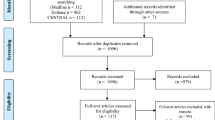Abstract
The optimal target of blood pressure (BP) in the acute phase of intracranial haemorrhage (ICH) is still controversial. Our aim was to evaluate safety and efficacy of intensive BP lowering compared to standard BP treatment in ICH. We conducted a systematic review and meta-analysis of all available randomized controlled trials recruiting patients with elevated BP in acute spontaneous ICH to intensive or standard BP-lowering treatment. Our primary outcomes were 3-month mortality, disability (modified Rankin Scale 3–5) and combined death or disability. Secondary outcomes were early neurological deterioration at 24 h, substantial haematoma enlargement within 24–72 h and 3-month non-fatal serious adverse events. We included six studies for a total of 4385 patients (mean age 62 years, 62.3% men). No differences were detected between the two treatment groups in 3-month mortality (RR = 0.99, 95% CI 0.83–1.17), disability (RR = 0.96, 95% CI 0.89–1.03) and combined death and disability (RR = 0.97, 95% CI 0.90–1.03). The rate of patients with early neurological deterioration, substantial haematoma enlargement and non-fatal serious adverse events was similar in the two treatment groups (RR = 1.03, 95% CI 0.88–1.19, RR = 0.85, 95% CI 0.70–1.03, RR = 1.07, 95% CI 0.90–1.28, respectively). An intensive BP control in the acute phase of ICH is not beneficial and should not be recommended. Therefore, the systolic BP target of less than 140 mmHg that is now suggested by guidelines needs to be reconsidered.




Similar content being viewed by others
References
Sacco S, Marini C, Toni D, Olivieri L, Carolei A (2009) Incidence and 10-year survival of intracerebral a in a population-based registry. Stroke 40(2):394
Guan J, Hawryluk GW (2016) Targeting secondary haematoma expansion in spontaneous intracerebral hemorrhage—state of the art. Front Neurol 7:187
Van Asch CJ, Luitse MJ, Rinkel GJ, van der Tweel I, Algra A, Klijn CJ (2010) Incidence, case fatality, and functional outcome of intracerebral haemorrhage over time, according to age, sex, and ethnic origin: a systematic review and meta-analysis. Lancet Neurol 9:167–176. doi:10.1016/S1474-4422(09)70340-0
Qureshi AI, Ezzeddine MA, Nasar A, Suri MF, Kirmani JF, Hussein HM et al (2007) Prevalence of elevated blood pressure in 563,704 adult patients with stroke presenting to the ED in the United States. Am J Emerg Med 25:32–38
Morgenstern LB, Hemphill JC III, Anderson C et al (2010) Guidelines for the management of spontaneous intracerebral hemorrhage: a guideline for healthcare professionals from the American Heart Association/American Stroke Association. Stroke 41:2108–2129
Hemphill JC, Greenberg SM, Anderson CS, Becker K, Bendok BR, Cushman M et al (2015) Guidelines for the Management of Spontaneous Intracerebral Hemorrhage: a Guideline for Healthcare Professionals From the American Heart Association/American Stroke Association. Stroke 46(7):2032–2060
Anderson CS, Heeley E, Huang Y, Wang J, Stapf C, Delcourt C et al (2013) INTERACT2 Investigators. Rapid blood-pressure lowering in patients with acute intracerebral hemorrhage. N Engl J Med 368(25):2355–2365
Wang JG, Arima H, Neal B, Peng B, INTERACT Investigators et al (2008) Intensive blood pressure reduction in acute cerebral haemorrhage trial (INTERACT): a randomised pilot trial. Lancet Neurol 7(5):391–399
Antihypertensive Treatment of Acute Cerebral Hemorrhage (ATACH) investigators (2010) Antihypertensive treatment of acute cerebral hemorrhage. Crit Care Med 38(2):637–648
Butcher KS, Jeerakathil T, Hill M, Demchuk AM, Dowlatshahi D, Coutts SB, ICH ADAPT Investigators et al (2013) The intracerebral hemorrhage acutely decreasing arterial pressure trial. Stroke 44(3):620–626
Koch S, Roman JG, Forteza AM, Otero CM, Rabinstein AA (2008) Rapid blood pressure reduction in acute intracerebral hemorrhage: feasibility and safety. Neurocrit Care 8(3):316–321
Tsivgoulis G, Katsanos AH (2015) Intensive blood pressure reduction in acute intracerebral hemorrhage: a meta-analysis. Neurology 84(24):2464
Qureshi AI, Palesch YY, Barsan WG, Hanley DF, Hsu CY, Martin RL et al (2016) Intensive blood-pressure lowering in patients with acute cerebral hemorrhage. N Engl J Med 375(11):1033–1043
Bozzano V, Carandini T, Gruppo di Autoformazione Metodologica (2017) Intensive lowering of blood pressure in the acute phase of intracranial haemorrhage. Intern Emerg Med 12(3):379–380
Schreuder FH, Sato S, Klijn CJ, Anderson CS (2016) Medical management of intracerebral haemorrhage. J Neurol Neurosurg Psychiatry 88(1):76–84
Hill MD, Muir KW (2013) INTERACT-2: should blood pressure be aggressively lowered acutely after intracerebral hemorrhage? Stroke 44(10):2951–2952
Higgins JPT, Thompson SG, Deeks JJ, Altman DG (2003) Measuring inconsistency in meta-analyses. BMJ 327(7414):557–560
Higgins JPT, Green S (2011) Cochrane Handbook for Systematic Reviews of Interventions. Version 5.1.0 [updated March 2011]. The Cochrane Collaboration Available from http://www.handbook.cochrane.org
Jusufovic M, Sandset EC, Bath PM, Berge E (2014) Blood pressure-lowering treatment with candesartan in patients with acute hemorrhagic stroke. Stroke 45(11):3440–3442
Potter JF, Robinson TG, Ford GA, Mistri A, James M, Chernova J et al (2009) Controlling hypertension and hypotension immediately post-stroke (CHHIPS): a randomised, placebo-controlled, double-blind pilot trial. Lancet Neurol 8(1):48–56
Pan C, Hu Y, Liu N, Zhang P, Zhang YP, Aimaiti M et al (2015) Aggressive blood pressure lowing therapy in patients with acute intracerebral hemorrhage is safe: a systematic review and meta-analysis. Chin Med J (Engl) 128(18):2524–2529
Ma J, Li H, Liu Y, You C, Huang S, Ma L (2015) Effects of intensive blood pressure lowering on intracerebral hemorrhage outcomes: a meta-analysis of randomized controlled trials. Turk Neurosurg 25(4):544–551
Acknowledgements
We acknowledge the Gruppo di Autoformazione Metodologica (GrAM) for the support.
Author information
Authors and Affiliations
Corresponding author
Ethics declarations
Conflict of interest
The authors declare that they have no conflict of interest.
Statement of human and animal rights
This article does not contain any studies with human participants or animals performed by any of the authors.
Informed consent
None.
Rights and permissions
About this article
Cite this article
Carandini, T., Bozzano, V., Scarpini, E. et al. Intensive versus standard lowering of blood pressure in the acute phase of intracranial haemorrhage: a systematic review and meta-analysis. Intern Emerg Med 13, 95–105 (2018). https://doi.org/10.1007/s11739-017-1716-7
Received:
Accepted:
Published:
Issue Date:
DOI: https://doi.org/10.1007/s11739-017-1716-7








